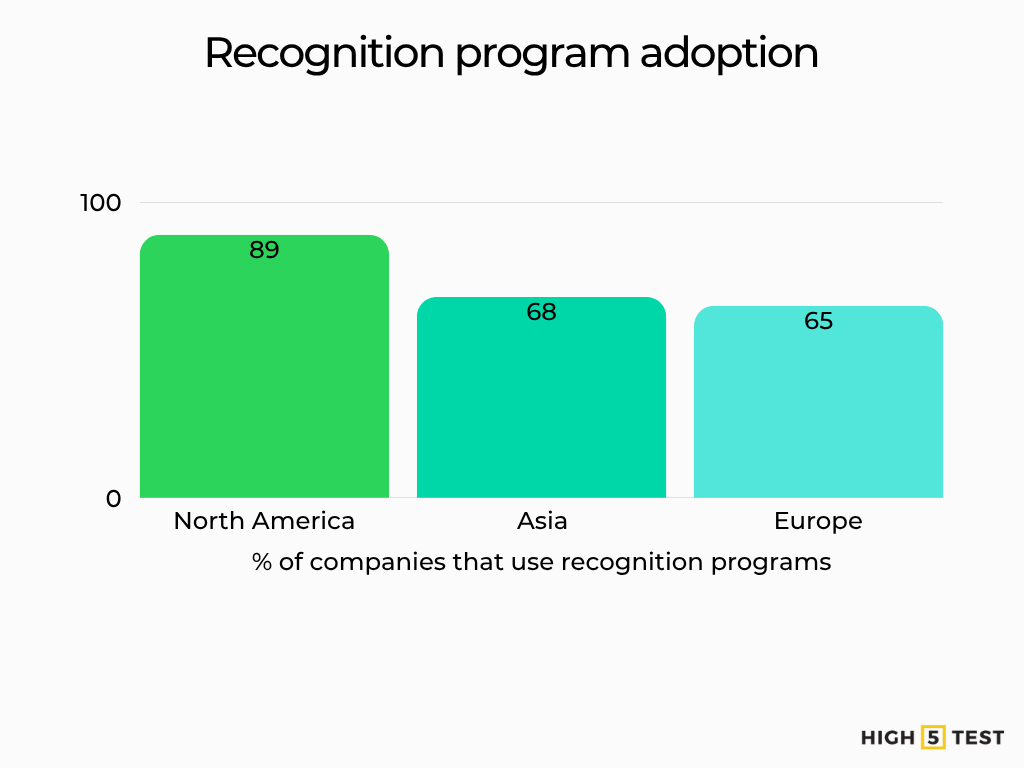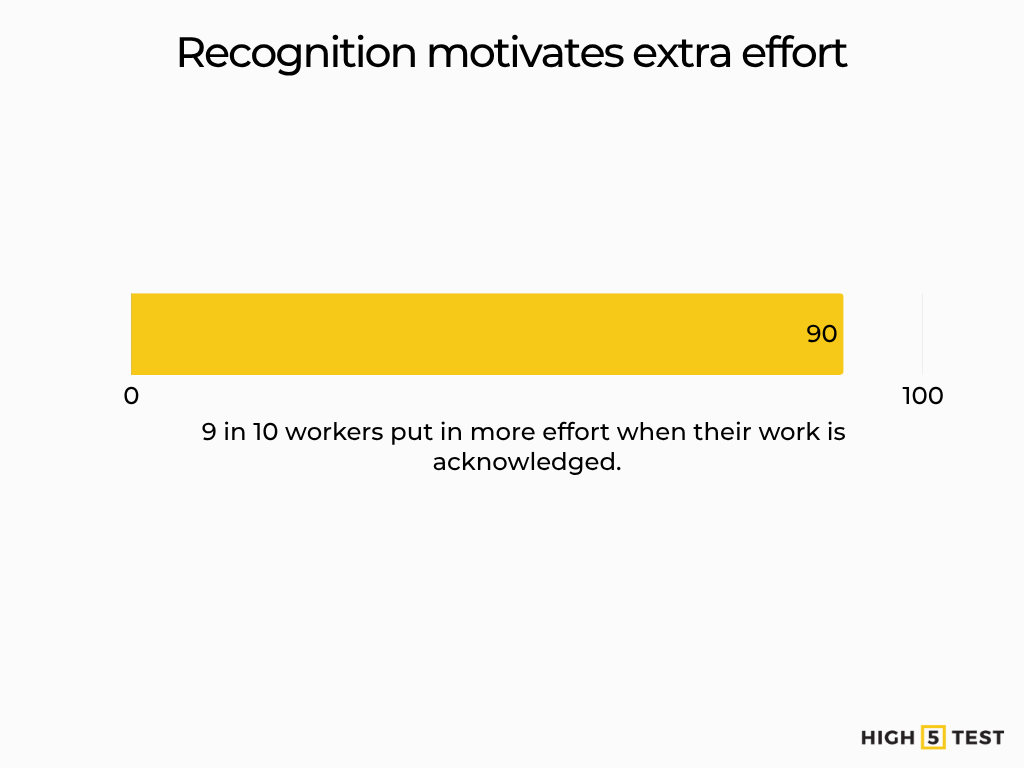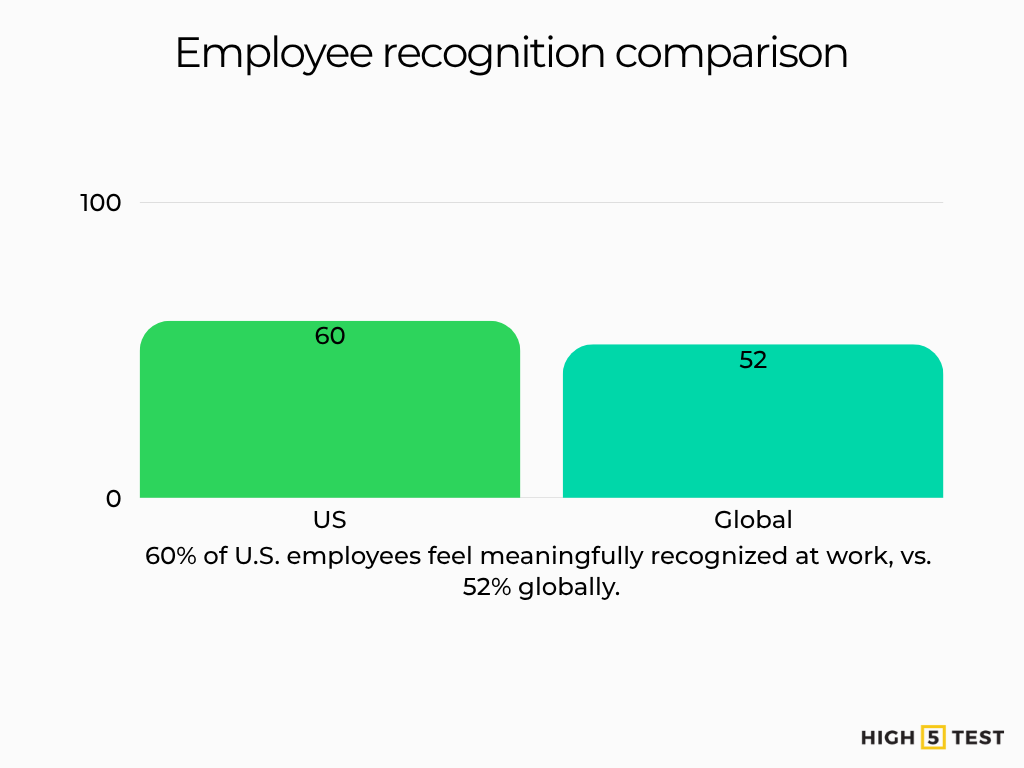Employee recognition isn’t just a feel-good nicety; it’s a business imperative. U.S. workers say feeling appreciated boosts their motivation, and those recognized consistently are less likely to quit within two years. Companies that cultivate a recognition-rich culture see lower voluntary turnover, while regular acknowledgment delivers an increase in productivity and twofold growth in employees reporting a sense of belonging.
This report explores the latest U.S. trends in employee recognition, unveiling how recognition frequency, peer vs. manager acknowledgment, and recognition platforms influence workforce outcomes. With industry benchmarks and year-over-year data for 2024 and 2025, we empower HR leaders to build high-retention, high-performance workplaces driven by culture and appreciation.
10 most important employee recognition statistics
- 51% of U.S. employees were actively looking for or open to leaving their jobs in 2024, showing just how high turnover risk remains.
- 60% of U.S. employees feel meaningfully recognized at work, vs. 52% globally.
- Employees who get high-quality recognition are 45% less likely to leave within two years.
- Employees who don’t feel recognized are twice as likely to quit within the next year.
- When recognition meets at least four pillars of quality (authentic, timely, equitable, etc.), workers are up to x times more likely to be engaged.
- Only 32% of employees strongly agree they receive fair recognition – Black (30%) and Hispanic (27%) employees are less likely to feel recognized equitably.
- Roughly 40% of employees receive recognition just a few times a year or less, despite 67% of managers giving weekly praise.
- 77% of employees who feel recognized express strong loyalty to their organization, compared with only 23% who agree their workplace has formal recognition systems.
- Companies lacking a recognition focus see 73% of employees more likely to feel burned out.
- Recognition saves real dollars: a U.S. firm with 10,000 employees can save up to $16.1M annually in turnover costs simply by embedding recognition into culture.
50+ employee recognition statistics in the US (2024 – 2025)
In 2024, employee turnover and disengagement remain key challenges in the workplace. According to recent research, 51% of U.S. employees are either actively looking for a new job or open to switching employers.
Source: Gallup
Despite this, only 22% of employees feel they receive adequate recognition for their work.
Source: Gallup
Recognition is a low-cost but high-impact strategy that significantly boosts morale and productivity. For instance, employees who feel well-recognized are 45% less likely to leave their company within two years. Those who don’t receive recognition are twice as likely to quit. In short, praising and rewarding staff is linked to higher engagement and loyalty.
Source: Gallup, Select Software Reviews
Stats on recognition program adoption & access
89% of North American companies have recognition programs (versus 68% in Asia, 65% in Europe).
Source: Trendicators

Only 29% of employees have access to recognition software. While ~53% have some program, fewer than one-third report using a dedicated platform.
Source: Nectar
52.6% of U.S. employees have a formal recognition program at work. In a 2024 survey, just over half of workers reported that their employer had a structured recognition program.
Survey: Nectar
92% of employees in firms with recognition programs feel valued (vs. 70% without). Data show that organizations with formal programs see far more workers feeling valued.
Source: Nectar
Emphasis on non-monetary rewards: About 55% of employees prefer non-cash recognition (like thank-you notes, public praise) over monetary rewards. Simple gestures often carry deep meaning.
Source: McKinsey
Recognition statistics by source and type (manager vs peer; monetary vs non-monetary)
Managers are the most impactful recognizers: 40% of employees rank their manager as the most influential source of recognition.
Source: Nectar
Another research study similarly found managers provided the most “memorable” recognition (28%), followed by CEOs (24%).
Source: Gallup
Peer-to-peer recognition matters: 41% of employees want recognition from peers, compared to 37% who want it from managers.
Source: WorkHuman

In practice, 63% of workers report receiving peer recognition at least weekly.
Source: Nectar
Report notes peer recognition can boost employee performance by 14%.
Source: Vantage Circle
Non-monetary vs. monetary rewards: As above, a strong majority (55%) prefer non-monetary rewards.
Source: McKinsey
Another research emphasizes that “money isn’t the only form of recognition,” noting that personalized praise can be even more memorable.
Source: Gallup
Recognition frequency and impact: Frequent recognition drives results. Survey reports that daily, weekly or monthly shout-outs make 98%, 94%, and 88% of employees feel valued, respectively, versus only 37% with annual feedback.
Source: Nectar
Stats on recognition and its impact on engagement, motivation & performance
90% of employees say recognition motivates extra effort. A 2024 report found that 9 in 10 workers put in more effort when their work is acknowledged.

Source: Achievers
82% feel enthusiastic if recognized at least monthly. Regular, genuine praise correlates with high energy on the job.
Source: Achievers
45% of monthly-recognized employees are “very engaged.” The data show twice as many highly engaged employees among those recognized monthly versus those who aren’t.
Source: Achievers
Employees who feel undervalued are 5x times as likely to be disengaged. Research reports that employees feeling underappreciated have five times the odds of disengagement.
Source: WorkHuman
Conversely, when recognition meets quality criteria (authentic, timely, equitable, etc.), workers are 4x times more likely to be engaged.
SourceL WorkHuman
92% repeat behavior they were recognized for. Receiving authentic praise reinforces desired actions.
Source: Achievers
Peer-recognition boosts culture: Peer-to-peer recognition is about 35.7% more likely to drive financial growth than manager-only praise.
Source: Vantage Circle
Stats on employee recognition impact on retention and loyalty
Well-recognized employees have 45% lower turnover. Employees receiving high-quality recognition were 45% less likely to leave over two years.
Source: Gallup

Unappreciated employees are twice as likely to quit. Another study also notes that those feeling undervalued have double the quit-risk.
Source: Gallup
71% say more recognition would make them less likely to leave. The survey found that “a whopping 71%” of employees report that frequent recognition would curb their intent to resign.
Source: Nectar
Employees who received strong recognition were retained at a rate 45% higher over a two-year period.
Source: Gallup
Companies with strong recognition see 31% lower voluntary turnover. Research reports that companies with effective programs report roughly one-third lower attrition.
Source: Achievers
Similarly, Aberdeen research noted 31% lower turnover with formal programs
Source: LinkedIn
Recognized new hires are 2x less likely to quit in their first year.
Source: WorkHuman
Retention is a top HR priority. Half of HR leaders rate retention a top-3 strategic goal, and many cite recognition as a key tool to achieve it.
Source: Achievers
Stats on employee recognitions and business outcomes (productivity & profitability)
21% higher productivity from recognition-driven cultures. The data found that organizations that prioritize recognition see productivity jump by 21%.
Source: Achievers
Employees recognized monthly report 2x times higher productivity. Workers getting at least monthly praise via an online platform are twice as likely to say they’re productive.
Source: Achievers
Engaged companies earn 23% higher profits. Another research has long shown that highly-engaged organizations are 23% more profitable than average
Source: Gallup
Recognition is a key driver of that engagement.
$1 spent on recognition can yield ~$5–7 in ROI. Workhuman cites data that strategic recognition investments produce five- to seven-fold returns in performance.
Source: WorkHuman
HR leaders say recognition improves business results: A Report found 90% of HR professionals agree an effective recognition program boosts business outcomes, and 91% say it positively impacts retention.
Source: Reward Gateway
1% payroll on recognition yields 79% higher goal achievement. Report shows that companies spending at least 1% of payroll on recognition hit their business goals 79% more often than those spending less.
Source: LinkedIn
Improved customer and financial results: Employee recognition also correlates with better customer satisfaction and innovation, as reinforcing good work aligns employee behaviors with company goals.
Source: CEO Weekly
Global & US workplace recognition stats comparisons
60% of U.S. employees feel meaningfully recognized at work, vs. 52% globally. In a survey, Americans rate recognition higher than the global average.

Source: Achievers
Asia and Europe lag behind North America. The data show 89% of North American firms have recognition programs, versus 68% in Asia and 65% in Europe.
Source: Trendicators
Engagement gap: Only 33% of U.S. workers report being engaged, highlighting that even in countries with many recognition programs, many employees still feel disconnected, suggesting existing programs aren’t fully effective.
Source: Gallup
Australia: 52% of Australian workers receive monthly recognition, but only 15% say it feels meaningful, indicating a frequency vs. quality disconnect.
Source: Achievers
Singapore: 32% of Singaporean employees cite not feeling valued (recognized) as the main reason they would leave their job.
Source: Achievers
By industry/size: While specific stats by sector or company size are scarce, larger organizations often use formal platforms, whereas small firms rely on informal methods. (Future content can explore this.)
Recognition statistics breakdown by gender
Gender, race and ethnicity
Women in tech: Face recognition gaps, impostor syndrome, lack of visibility, glass ceiling.
Source: Arxiv
Women receive less frequent recognition: 36% of women never receive recognition from executives, and only 41% get weekly praise from managers (versus 53% of men).
Source: Nectar
Employee recognition stats compared by country
United Kingdom (UK)
With a 59% appreciation score, UK organizations demonstrate a broad adoption of recognition practices, which likely include formalized programs.
Source: OC Tanner
Employees receiving frequent recognition are 8x times more likely to feel a sense of belonging and 5x times more likely to stay with their employer for over two years.
Source: OC Tanner
Burnout is 85% less likely among UK workers with strong recognition cultures.
Source: OC Tanner
UK engagement is weak: only 10% of employees feel engaged
Source: Gallup
Recognition breakdown by age and generation (UK)
- Gen Z (18 – 24): 68% feel under-recognized; highest productivity drop; rely on digital recognition.
- Millennials (25 – 35): Feel under-recognized; mental health impacted.
- Gen X (35 – 44): 70% want more recognition; 29% job-shopping due to lack. Prefer salary or promotions over digital praise.
Source: Wild Goose
Canada
87% of Canadians consider employee recognition important, vs. 78% in the U.S. Formal recognition from managers is lower: Canada reports 34%, compared to 50% in the U.S.
Informal recognition is also lower: 17% in Canada vs. 34% in the U.S.
Source: Wikipedia
Canada ethnicity layers: As visible minorities grow (~26.5%), equitable recognition becomes crucial.
Source: Wikipedia
India
India leads in motivation: 84% of Indian employees are motivated to go the extra mile, compared to 75% in the U.S.
Source: EFX
Australia
Interestingly, 52% of Australia’s workers are recognized monthly, but only 15% feel truly recognized.
Source: Achievers
Stats on employee recognition by industry-level
Finance & insurance (UK): Highest happiness among well-paid employees – £85,538 avg. salary – but still leave if undervalued.
Source: Financial Times
Tech & telecom (UK): 52% of UK tech professionals now view purpose as essential (up from 27% in 2024), yet only 34% feel authentic at work and 33% see their workplace as inclusive.
Source: Michael Page
Small vs enterprise (Global): Large firms use formal platforms; small businesses rely on daily verbal praise.
Employee-owned firms (UK): Show 10–12% higher productivity, better pay, stronger training, recognition embedded in ownership culture.
Source: Employee Ownership
Future trends in employee recognition and satisfaction
GenAI adoption in HR doubled from mid-2023 to early 2024. Key focus areas include chatbots, admin automation, and skills data tools.
Source: McKinsey
Social platforms boost recognition-based engagement by 30%.
Source: Forrester
Gamification, like points and leaderboards, drives 40% higher participation.
Source: Research Gate
Diversity-focused recognition resonates with 68% employees, enhancing inclusivity.
Source: SHRM
Sustainability-linked rewards preferred by 55%, aligning with modern values.
Source: Keevee
UK & PwC: 40% of organizations exploring AI in reward systems; 10% implementing.
Source: PWC
L&D & recognition integration: Training budgets rising; growth opportunities increasingly tied to recognition and satisfaction.
Source: Compono
FAQ
What is employee recognition?
Employee recognition refers to formal or informal programs and practices that acknowledge and reward workers’ efforts and achievements. It can range from a simple “thank you” to awards or bonuses. Effective recognition is personalized and timely, and research shows it boosts engagement, productivity, and loyalty
Why is employee recognition important in the workplace?
Recognition has a strong impact on key business outcomes. For example, workers who feel unrecognized are twice as likely to quit. Whereas recognized employees are 45% less likely to leave within two years. Recognizing employees’ contributions also increases motivation and performance.
What types of employee recognition are most effective?
Manager-led recognition is highly impactful, but peer-to-peer recognition is also important. Non-monetary rewards like thank-you notes and public praise are often more valued than cash. Consistent and frequent recognition is most effective.
How does employee recognition affect retention?
Strongly. Employees who do not feel sufficiently recognized are about 2x times as likely to say they’ll quit within a year. Conversely, companies with robust recognition programs report roughly 31% lower voluntary turnover. In fact, 71% of workers in one survey said they would be less likely to leave if they were recognized more often.
How often should employees be recognized?
Frequent recognition is best. Data suggest that weekly or monthly recognition has the most impact: 94 – 98% of employees feel valued when recognized weekly/daily, versus just 37% on an annual schedule. The report even recommends acknowledging employees at least every seven days.
What is the difference between employee recognition and rewards?
Recognition is broader than monetary rewards. It includes praise, thank-you’s, and non-cash perks as well as financial incentives. Research shows 65% of employees prefer non-monetary recognition (personal notes, public shout-outs) over cash. Effective programs often combine both to reinforce performance.
Which industries or company sizes most commonly use recognition programs?
Large U.S. organizations (especially North American companies) are more likely to have formal recognition systems than smaller or foreign firms. For example, about 89% of North American companies report having a program, versus 68% in Asia. Many small businesses rely on informal, verbal praise due to resource constraints.
What are examples of employee recognition?
Examples include verbal praise during meetings, handwritten thank-you notes, employee-of-the-month awards, peer-nominated shout-outs, spot bonuses, extra time off, and public recognition on internal platforms.
What are the benefits of employee recognition?
Recognition boosts employee morale, engagement, retention, productivity, and job satisfaction. It also strengthens workplace culture and contributes to better team collaboration and performance.
What is the best way to recognize employees?
The best way is to be timely, specific, and personal. Tailor recognition to what the individual values—some prefer public praise, while others prefer private thanks or small tokens of appreciation. Make it regular and aligned with performance goals.
